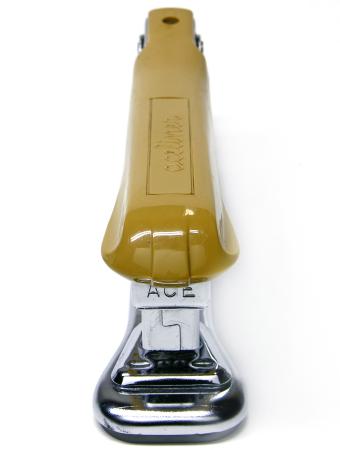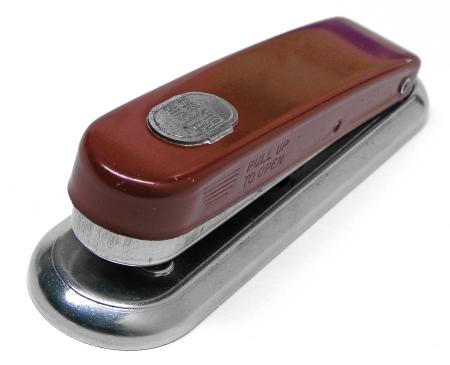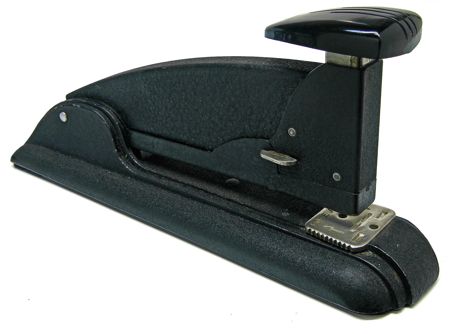ApologiaI do not collect staplers. It's not a hobby. I simply pick up the occasional stapler here and there that appeals to me. It's just a stapler fetish.
You can click any image for a larger version.
|
 Ace 102The classic. This was my first "fetish" stapler, one I bought not because I needed one, but because I loved the look of it. It turned out that a piece in back was missing, the part that the spring clip hooks onto and pushes the staples forward. I was able to rework a ballpoint pen clip to replace it. You can still buy these new, BTW.
Ace AcelinerThe Aceliner is probably the sexiest stapler ever made. This is the one that inspired the Stapler Fetish name. Like the Ace 102, the Aceliner is a classic design that is still available. I've also seen them in brown, dark red, tan, and tortoiseshell.
Ace PilotA smaller version of the 102.
ArrowUnknown ModelPatented 1943.
Bostitch B12Detroit styling at its best!
Bostitch B440SBThis odd-looking contraption is a booklet stapler. It's intended to staple the center spine of folded 8 1/2 x 11 sheets of paper. Like almost off of the staplers featured here, it was a thrift store find, and came along just as I needed this exact thing for some booklets I was assembling.
Hotchkiss Model 5c.1940s. One of the earliest manufacturers of wire strip staplers--arguably the very first commercially successful stapler manufacturer--Hotchkiss has ties to today's Swingline. Hotchkiss started out as the Jones Manufacturing Co, which made the Star Paper Fastener beginning in 1895. In 1897, the company name changed to E.H. Hotchkiss. In 1954, Vail, manufacturers of the Victor acquired Hotchkiss. ACCO, who also owned Swingline, then acquired Vail in 1965. So in a way, Hotchkiss lives on!
Markwell Featherweight RXThis exremely simple Featherweight RX dates from the late '40s. The Markwell company was founded by two brothers and took its name from their first products: crayons and markers. Later, they began marketing staplers manufactured by Acme and the Boston Wire Stitcher Co (later Bostitch). One of Markwell's innovations was designing a slightly slanted row of staples that worked only in their products. The RX staple (since discontinued) was one such type of staple. A few remain in this Featherweight. I probably won't ever use it, because once those remaining staples are gone, they're gone.
PrestoMade by Metal Specialties Manufacturing Company of Chicago, which applied the Presto name to a variety of products from its founding in 1902. This small, simple stapler with delightful Streamline Moderne lines was introduced in 1940 and appears to have been aimed at students, though examples of the Presto as advertising giveaways have been seen. A variation is the Presto DeLuxe, which has a squared top nameplate and enameled base.
Speed Model 4Speed Products changed their name to Swingline in 1956. This stapler is identical to the Swingline Model 4, so that's what I'm calling it.
Swingline 77SThis diminutive stapler came in a box along with some other office-related thrift store items. I think that there is supposed to be a base that it clips into.
Swingline 99Incredibly common. Incredibly awesome.
Swingline 99 PlierA compact, hand-held stapler with appealing lines that was made until recently.
Swingline 113XDAKA The Strongarm. This sucker is designed to chew through up to 110 sheets of paper. I had originally hoped to use it for the aforementioned booklet project, but it turns out that it isn't designed to staple fewer than 15 sheets at a time. It's truly a monster. To give some idea of its size, here is the 113XD with the Swingline 77S sitting on its bed.
Swingline 333No doubt the most dashing stapler ever created.
Tatum RascalAn extraordinarily ordinary stapler, save for the logo and back end curve.
Vail VictorNot to be confused with the 19th Century William Brown Victor, this Victor, with its imposing 2" diameter strike plate, was made by the Vail Manufacturing Co. probably between 1955 and 1964. Vail was acquired by ACCO (American Clip Company) in 1965, after which an identical stapler called the Monarch was made under the ACCO name. A rare variation is entirely chromed; this one has a bare aluminum base.
|
![]()






















